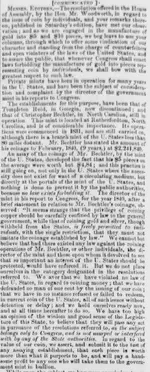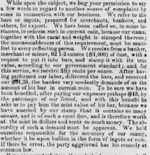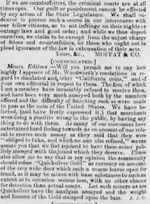Thanks to Kanacki. I had forgot about Columbia City Oregon story. Not to hijack the thread. Found my reference to Frank Fish, its Columbia CA lost treasure he was after.
Here's the story.
Frank Fish's Last Treasure Hunt
By Ben T. Traywick
World Renowned Author
In April 1963 death came to one of the most famous and successful of the treasure hunters, Frank Fish. To all appearances and evidence he died by his own hand. But did he? Frank was my close and personal friend; my family and I spent many hours in his Gold Rush Museum listening to him spin yarns of lost and buried treasures. To say the least, it is my honest opinion that Frank Fish was not the suicidal type. He loved his museum and its thousands of relics too well. In addition he was close on the track of a large treasure cache for which he had searched many years.
Like all treasure hunters, Frank was never prone to reveal locations or such. However, as I was a close friend, he did tell me a bit of what he was doing. He had found positive evidence that a large treasure had been hidden in the vicinity of Columbia, California.##M(READMORE)##
In 1850, the U.S. government cast raw gold into $20 gold pieces for the miners. This was done in order to place more legally minted money into circulation. As this service was performed free of charge practically all the miners took advantage of it.
A cast was made totalling $600,000. Four men and a team of mules left Columbia with this huge load of gold pieces to distribute them to the miners. The men hailed several riders a short distance out of Columbia, then disappeared never to be seen again.
Frank possessed letters and papers of the period which indicated that the popular belief was that the men had succumbed to the lure of all that gold and had stolen it. Though he did not indicate why, Frank firmly believed that the men had been ambushed by parties unknown, the wagon, mules, and gold coins stolen and the bodies so well hidden that no trace of them ‘was ever found.
Because of my skeptical remarks Frank laid three $20 gold pieces on the table before me and said:
“I traced the route taken by the men with the load of gold and where I believed would be a good spot for an ambush I went over very carefully with a detector. At one such spot I found these!” With a smile he indicated the gold pieces. By persistent questioning he finally revealed there were several more areas he wished to search.
I again visited Frank Fish at his museum in Amador City, late in October 1962. One look at his face and I felt a quick surge of excitement coupled with the instant thought, “He’s found it!” Frank motioned me over to a corner and began to tell me of his latest quest for the Columbia treasure. He had not found that particular treasure but he HAD found something else! This is what he told in his slow drawling speech:
“Ben, you remember I told you I was searching all the likely ambush places? Well, while I was doing that I spotted some unusual rocks sev-eral yards away in the brush. Upon investigation I found them to be the remains of an old cabin. I went over the entire area very carefully. About 20 yards from the old chimney I came to a shallow gully. On impulse I went down into it with the detector. There was a very strong indication of metal. My first excited thought was of $600,000 in gold. Frantically I began to dig, casting nervous glances over my shoulder to assure myself that no one was watching.
I first unearthed a Spanish sword, then a knife and quite unexpectedly, the remains of a skeleton. The skull was well preserved and had a bullet hole in the back. Further digging revealed an old pistol (later found to be a .69 caliber of the type used to assassinate Lincoln).
Still deeper I uncovered an earthen jar, called an olla by the Mexicans. It was heavy beyond imagination. Clearing the neck of it, I poured part of the contents into my hand. A stream of small, gold nuggets ran out. (At current prices the nuggets were worth $870.)
Even yet there appeared to be metal in that unusual gully! I continued to dig and dis-covered a small bean pot which was every bit as heavy as the olla had been! My trembling hands poured out its contents and my happy ears heard the musical clink of coins. The pot was filled to the brim with dirty, blackened- silver dollars!”
As he told me of each object he had found, Frank reached beneath the counter and laid each one before me; the rusty metal objects and the grisly skull which did indeed have a bullet hole thru the back. (A bone specialist later examined the skull and wrote Frank a letter stating that the hole was a bullet hole and had been made by a bullet of approximately 70 calibers).
I agreed that Frank had found a nice bit of loot, but where or what was the con-nection to the $600,000?
Grinning to show he was still ahead of me, Frank laid two more $20 gold pieces, dated 1850, on the counter. “I found these in the ruins of the cabin. I believe the holdup artists were there after they held up the gold wagon. Possibly they lived there before the hold-up and perhaps a while afterwards in order not to arouse suspicion. I can see no tie-in between the skeleton and the loot buried there. It is likely that someone else killed the man and buried him in the gully years before; the gully probably held its grisly secret even while the outlaws lived at the cabin. I am still convinced that the $600,000 is buried somewhere nearby.”
Frank Fish must have had ample reason to believe his last statement, but no amount of persuasion on my part could pry it from him. Only a sly grin answered my many ques-tions.
In January 1963, I was trans-ferred to Manitoba, Canada. Just before my departure I again visited Frank in Amador City. At that time he seemed in good health, high spirits, and full of enthusiasm over another impending trip to Columbia. He was planning a three day search in February.
I heard no more of Frank Fish until I learned of his death in April 1963. Shocked and unbelieving, I read he had taken his life. Frank Fish the treasure hunter I knew; a suicide! Impossible! It was utterly ridiculous to believe he would do such a thing. Further to substantiate my disbelief are the following: (1) He made no disposal of the 7,000 priceless items in his museum which he had spent his life collecting. (2) Apparently he made no pro-visions for his burial, as his body lies buried in the poorest section of the Jackson Ceme-tery, with only a small metal marker, supplied by the cemetery, as a means of identification. (3) Unasked he had promised me several items for my own museum; no provision was made for these. (One was the fantastic amount of literature and information he had col-lected on lost treasures and ghost towns). (4) During his extensive searching for the yellow riches at Columbia, Frank uncovered evidence of an Eng-lish settlement not previously known to historians. English items he found placed the date of this settlement at about 1600. Future new discoveries may reveal a complete por-tion of our country’s history heretofore completely unknown unless all this knowledge died with Frank Fish.
I am certain he would not have overlooked any of these items had he been contemplating death by his own hand. As he solved the mysterious riddles of lost and buried treasures in life, Frank Fish left behind, in death many unanswered questions.
Did he find the $600,000 in gold coins?
Did this treasure cause his death?
What connection, if any, was there between the skeleton, buried with gold and silver in the gulley, and the Columbia gold?
Did that $600,000 in gold lie buried somewhere near Columbia as Fish believed? Does it lie there yet? I probably knew more about Frank Fish and his treasure hunting activities than anyone. Yet I don’t know the answers to the mystery. I only know that the Frank Fish I knew would not take his own life intentionally or in such a manner.
Frank Fish's Last Treasure Hunt
By Ben T. Traywick
World Renowned Author



 Or early early settler golf course... haha!
Or early early settler golf course... haha!



